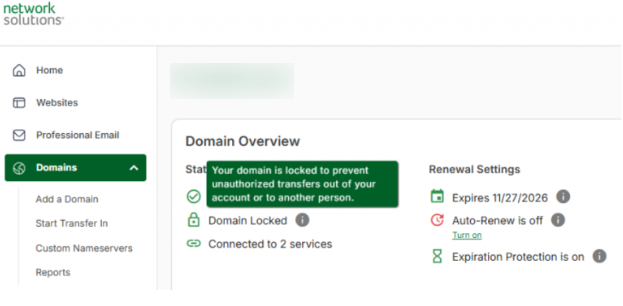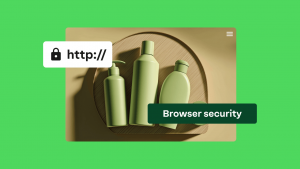Key takeaways:
- A stolen domain could mean lost traffic, broken email, damaged search engine optimization (SEO), and lost trust. For many businesses, it’s a full-blown crisis.
- Simple gaps like reused passwords or missing two-factor authentication make it easy for attackers to get in.
- Use registrar locks, enable Domain Name System Security Extensions (DNSSEC), monitor changes, and secure your email. These steps can stop hijackers before they get close.
Domain hijacking is a real and growing threat. In fact, researchers found that over 70,000 domains were hijacked using a method called “Sitting Ducks.” This attack doesn’t even require a password; it works by taking advantage of weak or misconfigured domain name system (DNS) settings.
That number is big. A stolen domain can cause a lot of damage. Many victims didn’t know their domains were taken over until traffic dropped or customers started reporting phishing emails.
In this guide, we’ll help you understand:
- What domain hijacking is
- How attackers get in
- What can go wrong
- How to lock down your domain before it’s too late
Ready? Let’s get started.
What is domain hijacking?
Domain hijacking or domain name hijacking is when an attacker takes control of your domain name without your consent. It often occurs through stolen registrar credentials, phishing, or security gaps at the registrar. After gaining access to your registrar account, the attacker can change ownership details or transfer the domain to another account.
This is different from domain squatting, where someone registers a similar name to profit from it, and from domain name system (DNS) hijacking (poisoning), where traffic is redirected by altering DNS records, but the domain itself is not stolen.
What is the difference between domain hijacking vs. DNS hijacking (poisoning)
Domain hijacking affects ownership at the registration level, while DNS hijacking alters the DNS resolution process to redirect traffic without transferring ownership.
| Attack | What happens | Do you lose domain ownership? | Main risks |
| Domain Hijacking (Domain Name Hijacking) | An attacker gains control of your domain registrar account and can transfer, lock, or sell your domain. | Yes | Permanent loss of your domain, brand damage, legal disputes |
| DNS Hijacking (DNS Poisoning) | DNS records are altered on a device, router, ISP, or public DNS server to redirect visitors to malicious sites without changing domain ownership. | No | Phishing, malware infections, stolen user data, loss of customer trust |
Note: While DNS hijacking can look similar, it does not involve stealing domain ownership. Instead, it redirects traffic by tampering with DNS records. For clarity, we cover it here as a related risk rather than a form of domain hijacking.
Both attacks are serious, but domain hijacking threatens ownership of your domain while DNS hijacking targets how your traffic is routed. Knowing the difference helps you apply the right security measures.

How does domain hijacking happen?
Hijackers use several methods to take over domains. Some target systems, others target people. Here’s how it typically happens:
- Phishing for registrar logins. Attackers send fake emails that look like they’re from your domain registrar. These often include urgent messages like account suspension warnings, with a link to a fake login page. Once you enter your credentials, they have full access.
- Attacker-in-the-middle phishing that can bypass multi-factor authentication. Attackers use real-time proxy phishing or intercept push approvals to capture one-time codes or tokens. In some cases, they pair this with SIM swap attacks. This allows them to get past MFA and seize control even when extra protections are enabled.
- Social engineering with registrars. Instead of hacking, some attackers simply pretend to be you. They contact your registrar, claim they’ve lost access, and try to convince support staff to hand over control.
- DNS record manipulation (DNS hijacking). Sometimes, attackers don’t need to own your domain. If they can access your DNS host, they can redirect your website traffic or email to malicious destinations, without changing domain ownership.
- Email account compromise. Your email, especially the admin contact tied to your domain, is a weak point. If attackers get into that inbox, they can reset registrar passwords and lock you out.
- Exploiting registrar vulnerabilities. Some hijackers take a more technical route, targeting weaknesses in registrar platforms or misconfigured security settings. If the registrar doesn’t enforce strict verification, this can lead to a silent takeover.
- Unauthorized domain transfer requests. Attackers may submit a domain transfer request and hope it goes through unnoticed. If your domain doesn’t have a transfer lock or up-to-date contact info, this tactic can work.
- Insider threats. Someone within your company, or a contractor, might have access to your domain settings. That access can be abused, either on purpose or by accident.
- Expired domain abuse. If a domain expires and isn’t renewed, attackers can re-register it. They may immediately use it to host malicious content, capture returning traffic, or impersonate the original brand.
Once a hijacker has access, he/she can:
- Get in. Via phishing, social engineering, or technical exploit.
- Take control. Change passwords, DNS, registrar settings.
- Exploit the domain. Redirect traffic, steal data, or sell it.
Once attackers gain control, every system tied to your domain becomes vulnerable — from your website and email to customer trust. The impact depends on how quickly the hijack is detected and what the attackers choose to do next.
What are the consequences if your domain is hijacked?
A hijacked domain takes your website offline and might disrupt everything connected to it. Here’s what you risk losing:
- Website and email downtime. Your site becomes inaccessible, and your email may stop working entirely, cutting off communication with customers and partners.
- Brand damage and loss of trust. If attackers use your domain for phishing or malicious content, it can seriously harm your reputation. Regaining trust is often harder than regaining access.
- SEO risks. Search engines may flag, penalize, or deindex your site. Even a short disruption can lead to long-term ranking issues and traffic drops.
- Loss of control over DNS and subdomains. Subdomains used for email, APIs, and integrations can break, affecting multiple business systems at once.
- Financial and legal impact. eCommerce businesses risk losing sales. If customer data is exposed or service contracts are breached, legal liability may follow.
How to prevent domain hijacking
Preventing domain hijacking means protecting your registrar account, DNS settings, and contact information. These six steps create multiple layers of defense and make it far harder for attackers to gain control of your domain.
- Enable two-factor authentication.
- Turn on registrar lock.
- Enable domain name system security extensions (DNSSEC).
- Use WHOIS privacy protection.
- Monitor domain expiry and auto-renew.
- Limit access and train your team.
1. Enable two-factor authentication
Passwords alone are easy to steal or guess, which makes them a common target for attackers. Two-factor authentication (2FA) adds a second step, usually a code from an app like Google Authenticator or Authy.
Even if someone gets your password, they cannot log in without that code. Turning on 2FA in your registrar’s Security Settings gives you an extra barrier that blocks most hijacking attempts.
2. Turn on registrar lock
One of the fastest ways attackers take over a domain is by transferring it to another registrar. Registrar lock, also called transfer lock, prevents this. If you registered your domain with Network Solutions, go to your Domain Management dashboard, and look for “Domain Lock” or “Prevent Transfer” and switch it on.
Once locked, your domain cannot be moved without your approval. This simple setting closes off one of the most common hijacking tactics.

3. Enable domain name system security extensions (DNSSEC)
Hijackers don’t always need to move your domain to cause damage; sometimes they target your DNS instead. DNSSEC, makes DNS records more trustworthy by verifying them with cryptographic keys.
Without DNSSEC, attackers could redirect your visitors to fake websites without your knowledge. Check your DNS Settings to see if it’s supported by your registrar and DNS host and enable it to protect your visitors from silent redirection.
Important: DNSSEC does not prevent domain hijacking at the registrar level. It only protects DNS integrity (prevents tampering and spoofing).
4. Use WHOIS privacy protection
Your contact details, such as email and phone number, are often published in public WHOIS records. Attackers use this information to send phishing emails or impersonate you with your registrar.
WHOIS privacy replaces (hides) those details with generic ones provided by your registrar. That way, attackers cannot directly target you. If your account doesn’t already include this feature, you can add it easily. For example, you can get WHOIS privacy or domain privacy protection directly with Network Solutions, which offers it as part of domain registration.
5. Monitor domain expiry and auto-renew
Forgetting to renew a domain is one of the easiest ways to lose it. If your domain expires, hijackers can immediately register it themselves. Setting your domain to auto-renew ensures this never happens.
Make sure your billing details are current in your billing settings, and consider enabling registrar alerts for changes or upcoming expirations. This small step protects your domain from being lost through oversight.
6. Limit access and train your team
Many hijackings succeed because someone with account access falls for a phishing email. Limit registrar and DNS access to only those who need it, and review account permissions regularly. If your registrar offers role-based controls, assign the minimum level of access required.
Pair this with regular training for your team so they can recognize fake registrar emails and suspicious login requests. An informed team reduces the chance of human error leading to a hijack.

What to do if your domain is hijacked already?
If your domain is hijacked, act fast. The sooner you move, the better your chances of getting it back and minimizing damage. Here’s what to do:
- Contact your domain registrar right away
- Gather any proof that shows you own the domain.
- Alert your DNS provider and email host.
- Escalate to Internet Corporation for Assigned Names and Numbers (ICANN) or your domain authority.
- Inform your users and customers quickly.
- Start damage control immediately.
- Contact your domain registrar right away. Submit a support ticket and call if they have a hotline. Clearly state that your domain has been hijacked and ask them to freeze all changes immediately.
- Gather any proof that shows you own the domain. This could be invoices, WHOIS history, email confirmations, or dashboard screenshots. The more you can show, the easier it will be to reclaim control.
- Alert your DNS provider and email host. Let them know what happened. They may be able to stop further damage, restore backups, or help with technical recovery.
- Escalate to Internet Corporation for Assigned Names and Numbers (ICANN) or your domain authority. If your domain registrar won’t cooperate or the hijacker moved the domain to another provider, file a complaint with ICANN or your country’s domain registry. You may also need to file a UDRP case to dispute ownership.
- Inform your users and customers quickly. Post an update on your social channels or a backup website. Let people know what’s going on and warn them not to trust emails or links from the compromised domain.
- Start damage control immediately. Change all passwords tied to your domain accounts. Check for other signs of intrusion, especially if the attacker accessed emails or DNS. If any data was exposed, notify affected users and follow privacy laws.
Real world domain hijacking examples
Real-world cases highlight just how disruptive domain hijacking can be, and how quickly it happens.
1. Sex.com: The $65 million domain theft
In the mid-1990s, con artist Stephen Cohen fraudulently transferred ownership of the domain sex.com from its rightful owner, Gary Kremen, by sending a forged letter to the registrar. Cohen profited from the domain for years before Kremen won a $65 million judgment in court. This case set a legal precedent: domain names are considered property that can be stolen.
2. Perl.com hijacked in 2021
In January 2021, the domain Perl.com was hijacked and redirected to a parked page. The attackers exploited vulnerabilities in the domain’s registration process. The incident disrupted the Perl programming community and highlighted the importance of securing domain accounts with strong authentication measures.
3. Google Vietnam and Lenovo hijacked in 2015
In February 2015, attackers hijacked Google’s Vietnam domain and Lenovo’s website by compromising their DNS records. Visitors were redirected to a defaced page. The incident was attributed to the hacker group Lizard Squad. Although this was technically a DNS hijack rather than a domain hijack, it underscores the risks of weak DNS security.
Protect your domain before someone else takes it
Domain hijacking can be silent, sudden, and devastating, but it’s preventable. Strengthening your registrar settings, enabling DNS protections, and monitoring for changes puts you ahead of most threats.
Check out Network Solutions’ private domain registration to hide your contact info and reduce phishing attempts. And add SiteLock website security to scan for threats and keep your site safe.
Don’t wait for a warning sign. Get protected now and take back control of your domain before someone else does.
Frequently asked questions
A domain owner should enable two-factor authentication on their registrar account, use private WHOIS to protect domain registration details, and monitor domain contact details regularly. These steps help reduce exposure to social engineering attacks and unauthorized transfers.
Preventing domain hijacking attacks at the domain registration level involves using reputable registrars, activating registrar locks, and enabling DNSSEC. These actions add layers of verification that make it harder for hijackers to gain unauthorized access to your domain name registrar’s system.
Yes, domain name hijacking can sometimes be reversed, but the process can be lengthy. Victims must provide proof of ownership and may need to pursue legal action through ICANN or the relevant domain registry to reclaim the original domain.
Unusual changes in DNS settings, unexpected registrar emails, or login alerts may signal domain hijacking attempts. Domain registrants should monitor WHOIS updates and DNS records frequently to spot changes early and act fast.
DNS poisoning is a method that attackers use to redirect users to fake websites without taking full control of a domain. While not always involving domain hijacking, it can be used in tandem to damage the reputation of a legitimate website.
WHOIS protection hides your personal and contact information from public view. Without it, hijackers can easily find and target your admin email. Using WHOIS protection is a simple yet effective way to prevent stolen domain names and reduce phishing attacks.
Legally, a stolen domain is treated similarly to stolen property. Courts may recognize the legitimate owner’s rights and restore access, especially in clear cases involving domain theft or unauthorized domain transfer.




